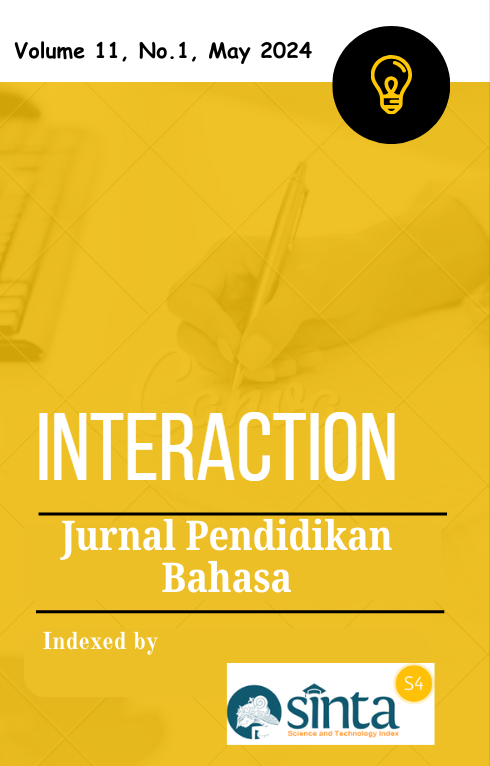Teachers' Strategies in Teaching Reading Comprehension in SMPN 7 Medan City
Abstract
Globalization has made English increasingly important as an international language in commerce, technology and education. Knowing how to speak English is certainly very useful and beneficial, given the importance of the English language. Of the four skills that teachers teach their students, reading is one of the most important skills in English and provides many benefits. This study examines the strategies used by English teachers to teach reading comprehension and their implementation at SMPN 7 Medan City. This research is descriptive qualitative in nature, using observation and interviews. Two English teachers served as informants in this study. The result of this study is based on the observation, the researcher first found that there are three strategies used by English teachers, namely (1) Scaffolding, (2) Question Answer Relationship (QAR) and (3) Discussion Strategy. Teachers use these strategies to help students understand the reading material. Students are encouraged to concentrate more on the text, and teachers can also assist students in developing the meaning of the reading material so that they can more quickly understand the content. In the Application of strategies used by English teachers to teach reading comprehension. First, scaffolding strategies that can create readable concepts are the methods used by the teacher. Second, this teacher uses the QARs strategy, where she asks her students about the terms she uses in the text after they finish reading it. Third, the discussion strategy which can make students more active in exchanging ideas when discussing with classmates. This method is used to ensure that students understand the text they read.
Downloads
References
Duffy, Gerald G. (2009). Explaining Reading: Resource For Teaching Concepts, Skillsand Strategies. New York: The Guilford Press.
Dwiningtiyas, G. N., Sofyan, D., & Puspita, H. (2020). Teachers’ Strategies in Teaching Reading Comprehension. JALL (Journal of Applied Linguistics and Literacy), 4(2). https://doi.org/10.25157/jall.v4i2.3682
Giawa, D. (2022). Teacher Strategies in Teaching Reading Comprehension At the Eighth Grade Student of Junior High School 1 Umbunasi. Jurnal Ilmiah Mahasiswa Keguruan , 1(2). https://jurnal.uniraya.ac.id/index.php/FAGURU
Harmer, J. (2007). The Practice of Language English Teaching. In Pearson Education Limited. Pearson Education Limited. https://doi.org/10.1080/03626784.1987.11075294
Hidayah, N., & Addinna, A. (2023). English Teachers ’ Strategies in Teaching Reading Comprehension at the Second Grade Students in SMPN 1 Panyabungan Selatan. Journal of English Languagel Teaching, l(4), 1185–1194.
Junita, T., Mukhrizal, & Elfrida. (2023). Teachers’ Strategies in Teaching Reading Comprehension At Senior High Schools. Wacana: Jurnal Penelitian Bahasa, Sastra Dan Pengajaran, 21(2), 110–126. https://doi.org/10.33369/jwacana.v21i2.29572
Mikulecky, B. S., & Jeffries., L. (2007). Advanced reading power : extensive reading, vocabulary building, comprehension skills, reading faster (Issue 112). Pearson Education, Inc.
Mulyono, & Wekke, I. S. (2018). Strategi Pembelajaran. Yogyakarta: CV. Adi Karya Mandiri.
Munna, A. S., & Kalam, M. A. (2021). Teaching And Learning Process To Enhance Teaching Effectiveness: A Literature Review. International Journal of Humanities and Innovation (IJHI), 4(1), 1–4.
Nadian, R., & Afifi, N. (2023). Teachers’ Strategies In Teaching Reading Skills During Offline Learning In Post Covid-19 Pandemic Period. Indonesian Review of English Education, Linguistics, and Literaturee, 1(1). https://jurnalfaktarbiyah.iainkediri.ac.id/index.php/ireel/index
Narina, L. R. (2022). Scaffolding Technique in Reading Comprehension in The Junior High School. Journal of Educational Study, 2(2), 142–150. https://doi.org/10.36663/joes.v2i2.275
Nurdianingsih, F. (2021). Teachers’ Strategies in Teaching Reading Comprehension. PROJECT (Professional Journal of English Education), 4(2), 285. https://doi.org/10.22460/project.v4i2.p285-289
Nurhayati, Manan, A., & Abdul, M. (2019). QAR Strategy For Effective Teaching Of Reading Comprehension. English Education Journal, 10(1), 95–111.
Pandiangan, T., Lumban Gaol, S. P., & Saragih, E. (2021). Reading Teaching Strategies Applied By English Teachers in Senior High School. Jurnal Pendidikan LLDIKTI Wilayah 1 (JUDIK), 1(02), 72–81. https://doi.org/10.54076/judik.v1i02.171
Sari, A. W., & Emelia, T. W. (2022). The Effect of Question Answer and Relationships (QAR) Strategy Toward the Students’ Achievement in Reading Comprehension of Narrative Text. Jurnal Riset Ilmu Pendidikan, 2(3), 143–149. https://doi.org/10.56495/jrip.v2i3.145
Snow, C. (2002). Reading for Understanding: Toward an R&D Program in Reading Comprehension. Santa Monica: Rand Education. https://doi.org/10.7249/mr1465.0
Solihin, R. K., & Muaz. (2022). the Use of Question Answer-Relationship (Qar) Strategy on Improving Students’ Reading Comprehension At Sman 1 Jatitujuh. Journal of English Language Learning, 6(1), 115–120. https://doi.org/10.31949/jell.v6i1.2747
Surayatika, D. (2022). Teachers’ Strategies in Teaching English for Young Learners. Global Expert: Jurnal Bahasa Dan Sastra, 10(1), 47–58. https://doi.org/10.36982/jge.v10i1.2229
Ulfa, A. A., Jabu, B., & Ariyani, A. (2023). An Analysis Of Teachers’ Strategies In Teaching Reading Comprehension. Journal of Technology in Language Pedagogy (JTechLP), 2(3), 549–559. https://doi.org/10.60012/cje.v1i2.45




.png)



22.png)
